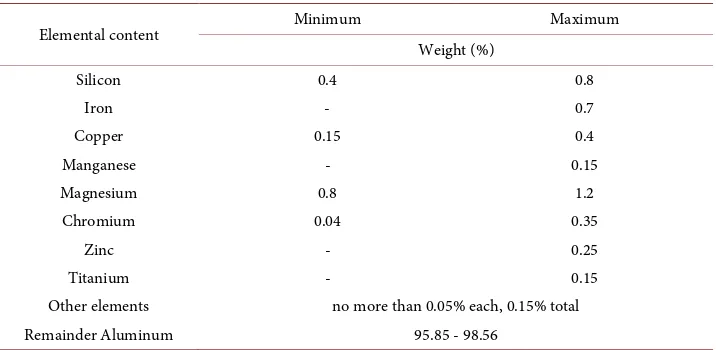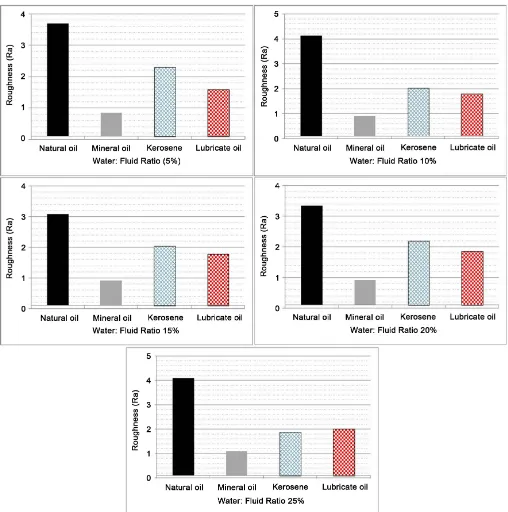http://www.scirp.org/journal/jsemat ISSN Online: 2161-489X
ISSN Print: 2161-4881
Vegetable and Mineral Used Oils as Cutting Fluids:
Effect on Surface Roughness of Aluminum Alloy
Nabeel Gharaibeh
Mechanical Engineering Department, Al-Balqa Applied University, Al-Huson University College, Irbid, Jordan
Abstract
The use of cutting fluids in mechanical machining operation is important to make cutting easy, produce low surface roughness, increase the rate of productivity, and alleviate the negative effect on work environment and operators. In this project the effect of using different cutting fluids on the surface roughness of aluminum alloy (T6-6061) was studied. The experiment involved the use of constant cutting parame-ters (cutting speed of 860 rpm, depth of cut at 1.5 mm, and feed rate of 0.12 mm/rev). Three local cutting fluids: mineral used oil, kerosene, and natural used oil (refined sunflower oil) mixed with water at different ratios (5%, 10%, 15%, 20%, and 25%) were used to study their effect on the surface roughness compared to a com-mon lubricate oil used in the cooling process. Results revealed that mineral used oil gave the lowest (best) roughness coefficient at 5% water ratio followed by lubricate oil. Kerosene and natural oil had the highest roughness coefficients. Mineral oil could be recommended for use with local cutting machines reducing the huge amounts of waste oil produced in the country.
Keywords
Cutting Fluid, Surface Roughness, Lubrication
1. Introduction
Lubricants or cutting fluids are oils and or fluids used to facilitate the motion of cutting machines. The purpose of using lubricating materials is to minimize friction and wear between interacting surfaces and to improve resulting surface finish, and increase tool life. In addition oils are used to decrease heat, prevent corrosion, transfer power, and to remove wear particles. Cutting fluids are of three main types: mineral, semi-synthetic, and synthetic. Generally lubricants are mixed with specific ratio of water to enhance lubricating oil to increase the coverage of surface and to decrease effect of temperature
How to cite this paper: Gharaibeh, N. (2016) Vegetable and Mineral Used Oils as Cutting Fluids: Effect on Surface Roughness of Aluminum Alloy. Journal of Surface Engi-neered Materials and Advanced Technology, 6, 176-182.
http://dx.doi.org/10.4236/jsemat.2016.64016
Received: August 9, 2016 Accepted: October 9, 2016 Published: October 12, 2016
Copyright © 2016 by author and Scientific Research Publishing Inc. This work is licensed under the Creative Commons Attribution International License (CC BY 4.0).
http://creativecommons.org/licenses/by/4.0/
(resist thermal breakdown). However, water is a good conductor of heat but its boiling temperature is low and cause rusting of moving parts and therefore it is not a good lu-bricant [1].
Cutting fluids, if not properly handled, may cause health hazards including skin dis-eases, exposure to heavy metals, and respiratory problems due to inhalation of toxic materials. When inappropriately discharged, cutting fluids can also cause serious envi-ronmental problems such as water resources pollution In addition, cutting fluids cost more than cutting tools [2] [3].
Being biodegradable and non-toxic, the use of vegetable oils as lubricants offers effi-cient way of minimizing waste and reducing health hazards. Many researchers studied the use of different types of vegetable oils such as rapeseed, canola, and coconut oil as an alternative for mineral oil [4].
Many scientists tested different type of lubricants and their effect on surface rough-ness of different surfaces. For example different types of sunflower vegetable oils were test compared to two commercial types. The use of such oils was reported to decrease surface roughness value at varying spindle speeds and feed rates during cutting [5]. In another study sunflower oil was compared to standard lubricant on brass alloys. Natu-ral oil (sunflower) results were comparable to that of the standard lubricant with its advantage of having lower cost [6]. The effect of minimum quantity lubrication (MQL) on tool wear and surface roughness used for cutting steel was also investigated. The concept of MQL is important since the use of waste fluids is an important issue in mi-nimization of hazard waste [7].
The objective of this work is to determine the influence of vegetable and mineral used oils as cutting fluids on surface roughness aluminum alloy during the use conven-tional turning machine.
2. Materials & Methods
2.1. Aluminum in General
actual value of fatigue limit for an application can be dramatically affected by the con-ventional de-rating factors of loading, gradient, and surface finish (chemical composi-tion of aluminum alloy is shown in Table 1).
2.2. Surface Roughness Measurement
Surface roughness is a component of surface texture. It is calculated by the deviations in the direction of the normal of a real surface from its ideal form. If these deviations are large, the surface is rough; if they are small, the surface is smooth. There are many dif-ferent roughness parameters in use, but Ra is by far the most common one. Although a high roughness value is often undesirable, it can be difficult and expensive to control in manufacturing. Decreasing the roughness of a surface will usually increase its manu-facturing costs. This often results in a trade-off between the manumanu-facturing cost of a component and its performance in application. Surface roughness (Ra) is the arithmetic average of the roughness profile RT-10 roughness tester (SM Metrology Systems) and cut off number was 0.8 mm and resolution of 0.001 μm.
2.3. Treatments
Aluminum alloy (T6-6061) was cut into 100 mm length with a diameter of 20 mm. Lathe machine was used with 860 rpm spindle speed, 0.12 mm/rev feed rate, and 1.5 mm depth of cut. Natural used oil, mineral used oil, kerosene, and lubricate oil were mixed with varying ratios of water (5%, 10%, 15%, 20%, and 25%) were used as cutting fluids.
[image:3.595.196.554.519.694.2]Obtained results showed that mineral used oil had the best surface roughness value (@ 5% water ratio) therefore this oil was tested at higher spindle speed (1400 rpm) us-ing the same feed rate and depth of cut. Surface roughness at cuttus-ing speed 1400 rpm spindle speed, 0.12 mm/rev feed rate, and 1.5 mm depth of cut was then used for min-eral used oil and lubricate oil at varying ratios of water (5%, 10%, 15%, 20%, and 25%). Values of surface roughness are given in Table 2.
Table 1. Chemical composition of aluminum alloy T6-6061.
Elemental content Minimum Maximum
Weight (%)
Silicon 0.4 0.8
Iron - 0.7
Copper 0.15 0.4
Manganese - 0.15
Magnesium 0.8 1.2
Chromium 0.04 0.35
Zinc - 0.25
Titanium - 0.15
Other elements no more than 0.05% each, 0.15% total
Remainder Aluminum 95.85 - 98.56
Table 2. Surface roughness at cutting speed 1400 rpm.
Water:Fluid Ratio Lubricate Oil Mineral Used Oil
0 1.5
5 0.98
10 1.04
15 0.96
20 1.15
25 1.2
3. Results & Discussion
Surface roughness of the work material fluctuated and increased slightly with water fluid ratio (Figure 1). The graphical relationship shown in Figure 1 was the average value of three measurements taken every time the experiment was stopped. Figure 1 also shows that the range of surface roughness value for each coolant condition varies. For example, the ranges of surface roughness were between 0.845 μm to 4.14 μm. For vegetable (natural) used oil coolant, the ranges of surface roughness were between 3.08 μm to 4.14 μm. With mineral used oil, the ranges of surface roughness were between 0.845 μm to 1.1 μm, for kerosene, the range values of surface roughness were between 1.88 μm to 2.3 μm and for new trade mark lubricate oil; the range values of surface roughness were between 1.6 μm to 2.02 μm.
The best (lowest roughness) roughness values were obtained in mineral used oil (0.845 μm) at 5% water: fluid ratio, lubricate oil (1.6 μm) at 5% water: fluid ratio, kero-sene (1.88 μm) at 25% water: fluid ratio, and vegetable oil (3.08 μm) at 15% water: fluid ratio. The highest surface roughness in natural used oil was (4.14 μm) at 10% water: fluid ratio, kerosene (2.3 μm) at 5% water: fluid ratio, lubricate oil (2.02 μm) at 25% water: fluid ratio, and Mineral oil (1.1 μm) at 25% water: fluid ratio.
Increasing the (water: fluid ratio) yielded inconsistent results regarding the value of the surface roughness. Chipping was not performed since aluminum has plasticity na-ture and there was no fragmented chips were observed; only continuous long chips were resulted during cutting process. According the obtained results the best roughness was obtained in mineral used oil at 5% water: fluid ratio using cutting speed of 860 rpm and depth of cut of 1.5 mm and feed rate of 0.12 mm/rev). Therefore based on these results; the cutting speed was increased to 1860 rpm using the same depth of cut and feed rate. The observed changes in surface roughness were increased from 0.98 μm to about 1.2 μm (Table 2).
Figure 1. Effect of different types of coolants and water: fluid ratio on surface roughness.
on the other hand, performed better than the used natural oil probably due its volatile nature which made penetration to the tool-work piece interface faster and hence better heat reduction. Kerosene is not lubricant and performed the third in terms of surface roughness after lubricate and used mineral oil and this may be due to dryness of the surface after repeated use which in term increased surface roughness compared to mineral and lubricate oil.
When the speed was increased, the rate of heat reduction capability obtained in this work most probably was decreased and therefore the surface roughness increased [9]. Still the obtained results were comparable to lubricate oil. Based on the study, it was conducted that influence of machining conditions on surface roughness concluded that the significant effects for surface roughness was cutting speed. The study showed that coolant concentration does not significantly affect the surface roughness. Machining at lower cutting speed resulted in better surface roughness.
Acknowledgements
The author would like to thank Eng. Ala’a Elrye’es form faculty of engineering, Balqa University and Eng. Abdullah Shbool from faculty of engineering, Jordan University of Science and Technology for performing lab analysis.
References
[1] Boyde, S. (2002) Green Lubricants. Environmental Benefits and Impacts of Lubrication, Uniqema Lubricants. Green Chemistry, 4, 293-307. http://dx.doi.org/10.1039/b202272a
[2] Braga, D.U., Diniz, A.E., Miranda, G.W.A. and Coppini, N.L. (2002) Using a Minimum Quantity of Lubricant (MQL) and a Diamond Coated Tool in the Drilling of Aluminum- Silicon Alloys. Journal of Materials Processing Technology, 122, 127-138.
http://dx.doi.org/10.1016/S0924-0136(01)01249-3
[3] Soković, M. and Mijanović, K. (2001) Ecological Aspects of Cutting Fluids and Its Influence on Quantifiable Parameters of the Cutting Processes. Journal of Materials Processing Technology, 109, 181-189. http://dx.doi.org/10.1016/S0924-0136(00)00794-9
[4] Skerlos, S.J., Hayes, K.F., Clarens, A.F. and Zhao, F. (2008) Current Advances in Sustaina-ble Metalworking Fluids Research. International Journal of Sustainable Manufacturing, 1, 180-202. http://dx.doi.org/10.1504/IJSM.2008.019233
[5] Kuram, E., Ozcelik, B., Demirbas, E. and Şık, E. (2010) Effects of the Cutting Fluid Types and Cutting Parameters on Surface Roughness and Thrust Force. Proceedings of the World Congress on Engineering, Vol II, London, 30 June-2 July 2010, 4 p.
[6] Hussein, S.G. (2010) An Experimental Study of the Effects of Coolant Fluid on Surface Roughness in Turning Operation for Brass Alloy. Journal of Engineering, 20, 3.
[7] Dhar, N.R., Kamruzzaman, M. and Ahmed, M. (2006) Effect of Minimum Quantity Lubri-cation (MQL) on Tool Wear and Surface Roughness in Turning AISI-4340 Steel. Journal of Materials Processing Technology, 172, 299-304.
http://dx.doi.org/10.1016/j.jmatprotec.2005.09.022
[9] Gokkaya, H. and Taskesen, A. (2008) The Effects of Cutting Speed and Feed Rate on Bue-Bul Formation, Cutting Forces and Surface Roughness When Machining Aa6351 (T6) Alloy.
Journal of Mechanical Engineering, 54, 521-530.
Submit or recommend next manuscript to SCIRP and we will provide best service for you:
Accepting pre-submission inquiries through Email, Facebook, LinkedIn, Twitter, etc. A wide selection of journals (inclusive of 9 subjects, more than 200 journals)
Providing 24-hour high-quality service User-friendly online submission system Fair and swift peer-review system
Efficient typesetting and proofreading procedure
Display of the result of downloads and visits, as well as the number of cited articles Maximum dissemination of your research work
Submit your manuscript at: http://papersubmission.scirp.org/


